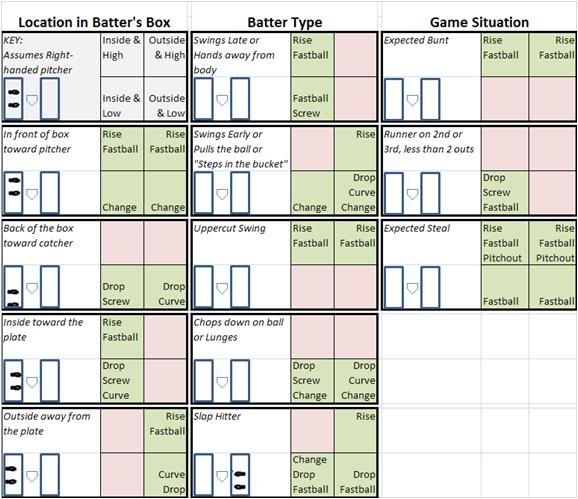In truth, this could be a stand-alone article because calling a game is an art unto itself. However, there is a method to my madness. We will discuss general pitch selection in this article, and in the next article we will discuss pitch selection when you absolutely need to get a ball into play in the first or second pitch. But I digress � back to general pitch selection.
If one is lucky, then they have a scouting report that indicates the tendencies of each batter on the opposing team. In truth, for Softball, even at the College level, this does not occur all that often. Most games are not televised, and few if any Softball staffs have any scouts on their staff.
However, in conference play over time, batter tendencies become known and in those cases, pitch to the known weakness of each batter (obviously!).
When facing an unknown opponent, though, about all one has to go on is the batter. Choosing which pitch to make is largely a matter of where the batter is in the batter�s box, what their swing looks like, and the count. One of the hardest things to teach a catcher when they are calling a game is to be aware of what the batter is doing while catching the ball, which we�ll cover on another day. Here, we�ll assume that the catcher can tell what kind of a swing the batter has and can call the appropriate pitches.
Now, again, the following is provided as a guide, but it�s much more important to know what pitch is working best that day, what the pitcher�s strengths are, whether she is right-handed or left-handed, what the strengths of the defense is, and the like. No two games will be called alike, even if the opponent is the same. So without further adieu, here are the pitches I recommend given that all pitches (fastball, curveball, change up, screw ball, drop ball, and rise ball) are effective (derived from �Coaching Fastpitch Softball Successfully� by Veroni & Brazier, �The Dominant Pitcher� DVD, and my own experience):

The above guide assumes a right-handed pitcher, and is given from the catcher�s perspective. For example, for a right-handed batter who sets up on the inside part of the batter�s box, the catcher could call a rise or fastball inside up in the strike zone, or a drop, screwball or changeup inside and low in the zone. Catchers should avoid calling pitches in the red parts of the strike zone. For a left-handed pitcher, generally substitute screwballs for curveballs and vice versa.
Obviously, a catcher and pitcher (and coach) must take all three variables (where in the box, type of batter, and game situation) into account when deciding what pitch and the location to call. Generally, if there are conflicts, select pitch and location based on where the batter is in the box, then by the type of batter, and then by game situation. When in doubt, I always tell my catcher to change speed and/or location from pitch to pitch unless they�re absolutely sure that a pitch will work back-to-back.
What does this have to do with the Pitch-to-Contact? A pitcher who is a dominant strikeout pitcher can overpower batters even if they miss in location (and pitch in the red above). A pitcher who is less-than-dominant MUST hit her spots, pitching to a batter�s weakness, to be successful.
BellaOnline Softball Subject List: Coach�s Box, Health & Medical, History of Softball, International Softball, Organizations, Parents , Professional Softball, Reviews, Rules & Regulations, Scorekeeping, Stats & Analysis, Travel Ball |


